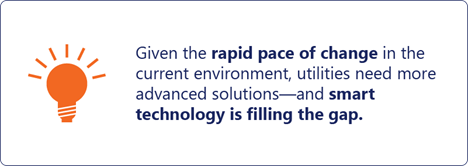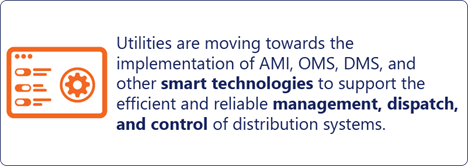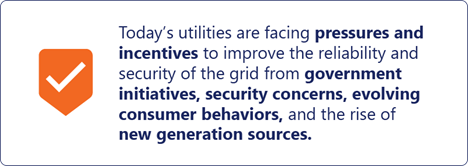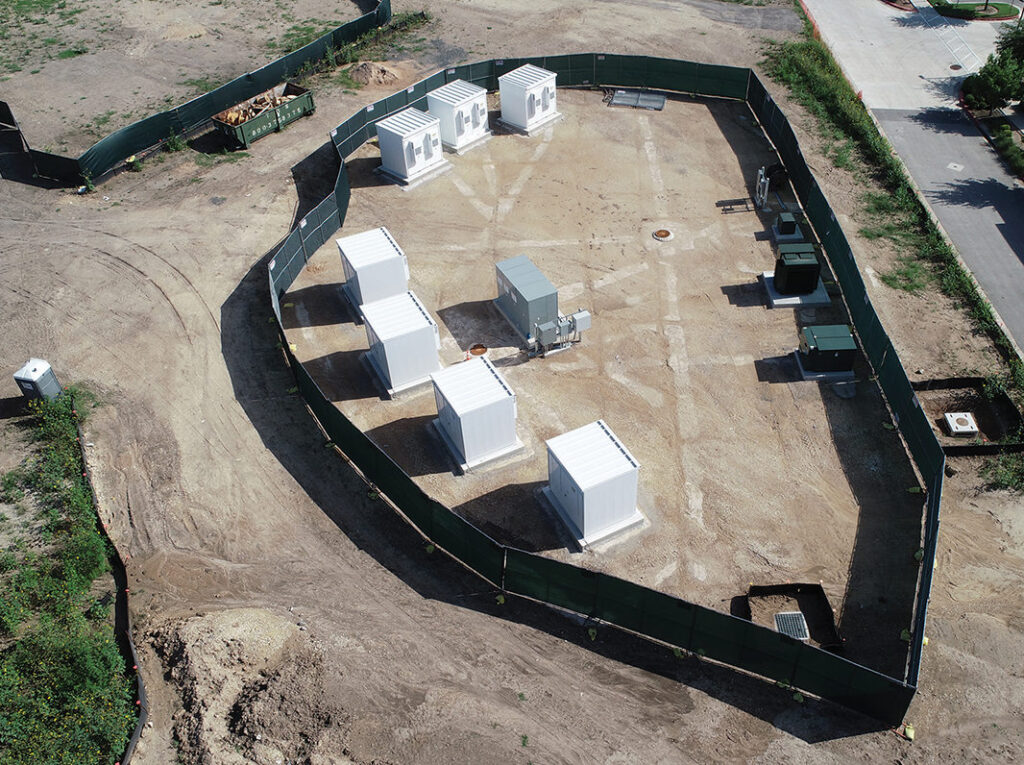How intelligent automation is shaping a more reliable power grid

Quick summary: Faced with increasing pressures to enhance the reliability and security of their grid operations, utilities are leveraging intelligent automation and reaping the rewards.
Since the dawn of the electrical age, monitoring and controlling all the moving pieces that make up secure, resilient power grid operations has been a challenge for utilities. Keeping power flowing safely and reliably requires rigid control over generation, transmission, distribution, and balance of supply and demand amid a sometimes-turbulent mix of variables.
TIME Magazine’s review of the Department of Energy’s most recent data revealed that the U.S. power grid currently spans more than 7,300 power plants, 55,000 transmission substations, and 160,000 miles of high-voltage power lines [1]. This complexity, coupled with a constantly shifting array of variables to which utilities must respond, has escalated the difficulty of grid operations to unprecedented levels.
While data science is nothing new to the utilities industry, adoption and evolution of automated technologies has historically moved at a slow, steady pace. However, given the rapid pace of change in the current environment, utilities need more advanced solutions – and the latest generation of smart technology is filling the gap. Intelligent automation offers solutions that are enabling utilities to keep up with the demands of an increasingly complex grid as well as regulatory requirements, security concerns, increasing electrification, and the rise of new generation sources.

The evolution of grid operations
Energy management systems (EMS) have been operational in utility companies for many years. These systems offered an array of functions, including supervisory control and data acquisition (SCADA), generation control and dispatch, generation scheduling, load forecasting, network analysis, and others. The products in this space have matured to the point where there is little change in functionality other than the incorporation and effective utilization of phasor measurement unit (PMU) measurements.
With the advent of wholesale power markets in the 1990s, utilities needed more rigid scheduling systems that use security constraints to calculate real-time and day-ahead energy and ancillary service schedules and prices. To this end, wholesale power market operators deployed systems with security-constrained unit commitment and security-constrained economic dispatch functionalities.
Starting in the early 2000s, smart grid efforts came to the forefront and the implementation of automation solutions made its way into distribution systems. Utilities are moving towards the implementation of advanced metering infrastructure (AMI), outage management systems (OMS), distribution management systems (DMS), etc. to support the efficient and reliable management, dispatch, and control of distribution systems. Smart automation and the integration of automated solutions have enabled advanced methods for identifying and tracking outages, for which utilities previously relied on customer reports.

Current drivers for improving power grid reliability and security
Today’s utilities are facing pressures and incentives to improve the reliability and security of the grid from multiple fronts.
Government initiatives
In early 2022, the U.S. Department of Energy introduced its “Building a Better Grid Initiative” [2] focused on spurring development of new and upgraded high-capacity transmission lines across the country. In addition, FERC appears to be ready to act on recent proposals giving state utility regulators a larger role in regional transmission planning and updating extreme-weather reliability standards.
Growing security concerns
Substation attacks in Washington and North Carolina in December 2022 are likely to spur action on the federal level to update physical security standards. In light of growing threats from hackers in Russia, China, Iran, and North Korea, FERC is considering new cybersecurity rules for DERs, and the DOE is currently funding “next generation” cybersecurity projects.
Shifting consumer behaviors
Electric vehicles (EVs) accounted for over 6 percent of new vehicle sales in Q3 of 2022 and could reach 10 percent in 2023. Given that the average EV requires 30 kilowatt-hours to travel 100 miles, this trend is driving an increase in electricity demand that will require long-term solutions on the part of utilities.
More customers are also impacting utility revenues by procuring their own energy solutions. In 2021, the U.S. Department of Energy reported that residential customers accounted for 16 percent of wind turbine installations [3] and the residential solar market experienced its fifth consecutive record year, growing 30 percent over 2020 [4], according to the Solar Energy Industries Association.
Renewables, green energy, and DERs
Both the U.S. federal government and a growing number of states are calling for 100 percent carbon pollution–free electricity, with target dates ranging from 2032 to 2050. In addition, the new federal regulation FERC Order 2222 is seeking to force the integration of distributed energy resources (DERs) into wholesale power markets.
As integration of renewable energy sources and DERs continues to escalate, grid operations must have the resilience to accommodate new generation sources while keeping transmission and distribution constant.

How technology is powering the next generation of grid ops
Given the rapidly changing environment and the urgency of internal and external drivers, utilities are being challenged to hit the accelerator on their efforts to modernize grid operations. Fortunately, digital technology is keeping pace with this need, enabling leading-edge solutions capable of elevating grid reliability and security.
Automation systems
Automation is hardly a new concept in the utilities industry, with some of the first SCADA systems dating back to the 1920s. Vendor products in this space are continuing to mature and now provide better decision-making tools for utility operations personnel.
With the deployment of automation systems nearing completion, a new focus on grid analytics by utilities has come to the forefront. Grid analytics encompasses a variety of tools designed to provide operators with capabilities to improve the safe, efficient, and reliable operation of the grid.
AI and machine learning
AI and machine learning are advancing grid operations by rapidly analyzing massive amounts of data—both historical and real-time—to drive better-informed decision making at all levels. Some of the latest use cases where utilities are leveraging analytics, AI, and machine learning include:
Asset management
Using real-time data from smart sensors and cameras, coupled with detailed historical information (e.g., equipment vendors, installation dates, maintenance records, weather patterns), AI-based platforms can alert utilities to grid assets that are at high risk of failure, enabling predictive maintenance that can prevent outages or safety hazards.
Vegetation management
AI solutions can rapidly analyze terabytes’ worth of drone images to identify vegetation encroachment and enable fast response by maintenance crews before a fire hazard can arise.
T&D investment planning
Utilities can leverage AI to take a data-driven approach to investment planning, ensuring that areas at highest risk for failure receive top priority and that healthy assets don’t divert resources away from where they are more urgently needed.
Edge technology and 5G wireless
Edge computing is enabling utilities to process data at or close to the location where it’s created—a handy capability in operating a grid that’s widely dispersed geographically, with assets often found in remote, inhospitable locales. And thanks to 5G wireless, data can move rapidly between edge devices and edge servers, enabling utilities to monitor and control devices in real or near-real time.
Looking ahead
Historically speaking, grid operations have evolved at a slow, steady pace. Today, however, a new generation of drivers—including government actions and increasing demand, are forcing utilities to accelerate their progress in keeping pace with a changing environment while also ensuring grid reliability and security. Fortunately, technology is enabling utilities not only to meet today’s challenges, but to take a proactive role in designing the future of grid operations.
About the Author
Managing Director of Grid Operations Alex Lago has over 30 years of experience in power system operations, wholesale power market operations, SCADA/EMS/GMS/DMS/OMS systems, and system/application design and implementation. He is passionate about advising companies on large-scale transformational projects and implementation of complex real-time operation systems.
Logic20/20 is a Solution Provider Member of Utility Analytics Institute.
References
[1] Bergengruen, V. “’Is There Something More Sinister Going On?’ Authorities Fear Extremists Are Targeting U.S. Power Grid” (TIME, 2023): https://time.com/6244977/us-power-grid-attacks-extremism/.
[2] U.S. Department of Energy, “Building a Better Grid Initiative to Upgrade and Expand the Nation’s Electric Transmission Grid to Support Resilience, Reliability, and Decarbonization” (Federal Register, 2023): https://www.federalregister.gov/documents/2022/01/19/2022-00883/building-a-better-grid-initiative-to-upgrade-and-expand-the-nations-electric-transmission-grid-to.
[3] The U.S. Department of Energy Office of Energy Efficiency and Renewable Energy, “Distributed Wind Market Report: 2022 Edition” (Energy.gov, 2022): https://www.energy.gov/sites/default/files/2022-08/distributed_wind_market_report_2022.pdf.
[4] Solar Energy Industries Association, “Solar Industry Growing at a Record Pace” (SEIA.org, 2023): https://www.seia.org/solar-industry-research-data.






